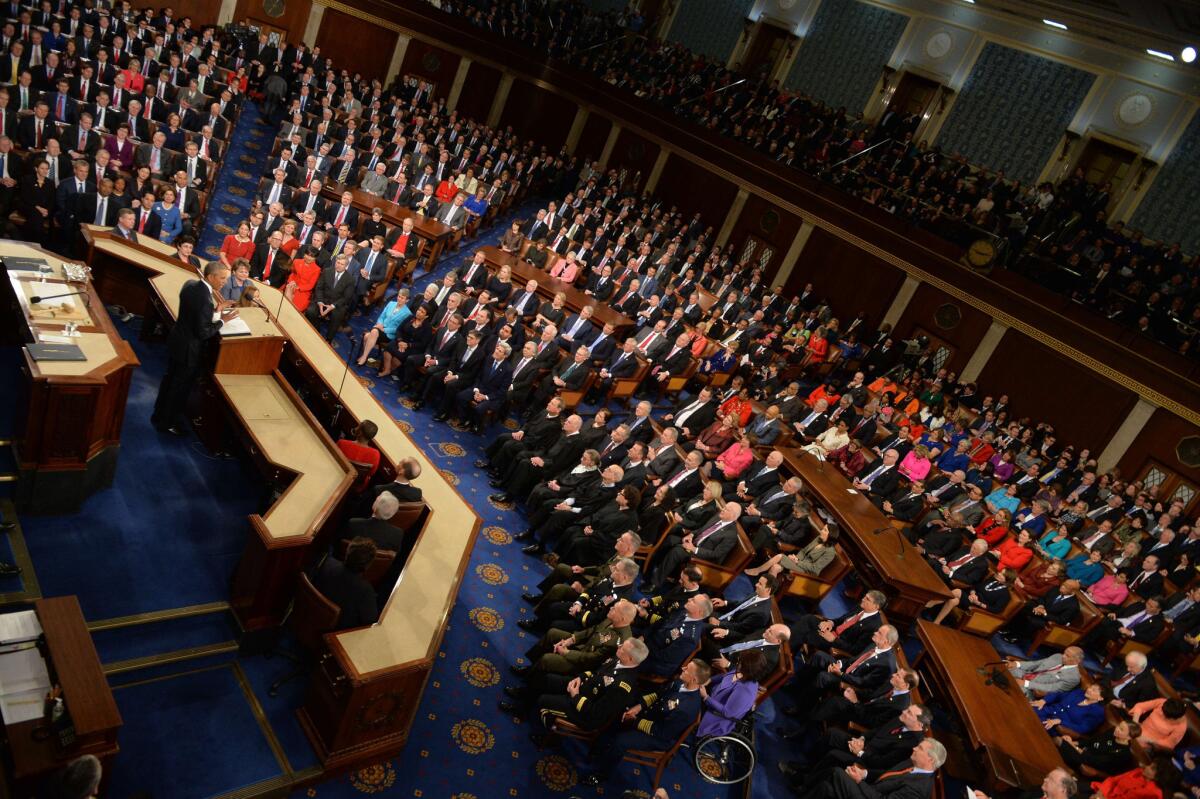Obama’s State of the Union pledge to push for bipartisan redistricting reform was a late add

President Obama delivers his final State of the Union address.
- Share via
President Obama used his last State of the Union address to push for national voting reforms and went off script to specifically call for bipartisan groups to draw new congressional districts instead of lawmakers.
“I think we’ve got to end the practice of drawing our congressional districts so that politicians can pick their voters and not the other way around,” he said before veering from his prepared remarks to add: “Let a bipartisan group do it.”
In recent days, aides to the president had said he was concerned about gerrymandering, the flood of money in politics and other barriers to voter participation.
In his speech, Obama declared that he plans to agitate for change, including reducing the influence of money “so that a handful of families or hidden interests can’t bankroll our elections.”
Obama did not specify how to institute such measures - but he promised to hit the campaign trail to promote them.
“This is America. We want to make it easier for people to participate,” Obama said. “And over the course of this year, I intend to travel the country to push for reforms that do just that.”
In most states, legislators have control over the drawing of congressional districts, often leading to poltically safe districts that protect incumbents.
That is a problem for Democrats, who have seen a thinning in their ranks in state legislatures around the country.
Democrats in 2015 controlled 919 fewer state legislative seats than they did in 2009, according to an analysis of National Conference of State Legislatures data by the Pew Research center.
“Democrats control both legislative chambers in just 11 states, down from 34 states in 1982 and 27 as recently as 2010, though that number had fluctuated in the years in between,” Pew reported last year.
Six states, including California and Arizona, have a commission with primary responsibility for drawing a plan for congressional districts, according to the National Conference of State Legislatures. Five other states have an advisory commission that may assist the legislature with drawing the district lines.
Redistricting expert Paul Mitchell said Obama’s line echoed calls by California Republicans a decade ago when they were pushing for a citizens redistricting commission to draw boundaries, instead of the Democratic-controlled Legislature. Voters approved that measure, and the commission drew new lines in 2011.
Mitchell said the nonpartisan citizens group succeeded in creating districts that prioritized keeping federally protected groups of minority voters together instead of crafting safe districts.
He pointed to the new 29th Congressional District in the San Fernando Valley, drawn to avoid breaking apart a heavily Latino population. Rep. Tony Cardenas (D-Los Angeles) became the Valley’s first Latino representative, while white incumbents Brad Sherman and Howard Berman were forced to run against each other in an adjoining district. (Sherman prevailed.)
The citizens commission also shifted the lines in a way that made more seats competitive, including those held by Democratic Reps. Ami Bera of Elk Grove and Scott Peters of San Diego. Traditionally, California’s Democratic-controlled Legislature would have drawn contorted districts to make the seats safe for the party.
More states, including Illinois, where Obama got his start in politics, are considering switching to commissions.
“When you strip away the politics and have it be in a nonpartisan setting, the district lines that get drawn are pretty good,” Mitchell said. “I can see there being a space and time right now for this kind of redistricting reform to catch hold.”
Times staff writer Christi Parsons contributed to this report.
Follow @jpanzar
For more, go to latimes.com/politics.
ALSO:
State of the Union full coverage: Obama says ‘I believe in change because I believe in you’
Looking to the future in his last State of the Union, Obama rekindles a familiar refrain: Hope
Analysis: California GOP benefits from redistricting decision as bigger case looms
More to Read
Get the L.A. Times Politics newsletter
Deeply reported insights into legislation, politics and policy from Sacramento, Washington and beyond. In your inbox three times per week.
You may occasionally receive promotional content from the Los Angeles Times.











